-
Posts
1,404 -
Joined
-
Last visited
Content Type
Profiles
Forums
Gallery
Events
Articles
Posts posted by extant4cell
-
-
Please let us know...
-
Armen, thank you for additional information and for showing this interesting coin. Forgive me for getting too excited and for missing to say one important thing. Please accept our condolences for you loss.
-
Hi Sigi,
I only have an electronic version of Fuchs publication. Didn't realise that one page was missing. Would be happy to add it if you'd share. Thank you,!
-
Did you keep the correspondence with Spasski? If you care to share that may shed additional light.
Can you weigh it again so you know for sure?
-
This is an original rouble from Hermitage:
The verdict is that your coin is similar (if not the same) to the one from the collection of U. Arslan from New Hollywood which is described in the literature as a counterfeit rouble.
Here is it's edge inscription:
I understand these pics are from this publication that includes Spasski's article on "New about Constantine Rouble 1825 and its counterfeits" and the pictures, I assume, in the article are taken from the photographs you supplied above:
Russian forum link, for more information (if you read Russian): https://www.staraya-moneta.ru/forum/messages/forum2/topic276529/message3003990/#message3003990
If my assumption is correct and that it is the same coin, I believe if you sell it as an antique counterfeit rouble from Arslan's collection, known as a Hollywood Constantine rouble, well described and published in Spasski's article, and if you would include the original photographs taken for Spasski publication in the auction, it will still bring you some surprising money.
-
Very peculiar. Our sentiments and suspicions are understandable here. There are a lot of fakes going around, and with the time situation is only getting worse. You may need to take coin to one of the Auction houses for expertise when the COVID19 situation is under control. I am not an expert in silver Constatine I roubles by any account, but I am actually impressed by it. It looks genuine to me. If it will be confirmed as genuine, it may bring you good money would you sell it at a proper auction house. See here: https://www.m-dv.ru/en/catalog/id,4677/prohod.html
Looking through the pictures that I could access in acsearch.info and on m-dv.ru,, it is the most interesting and beautiful coin on a picture I've ever seen of this type. It is strikingly similar to the very coin sold in 1965 for $41,000.00 and looks proper:
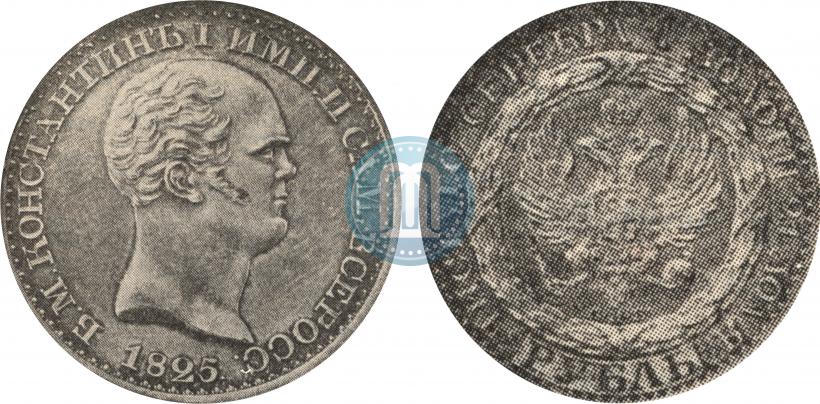

I may show it on Russian speaking site for a second opinion.
By the way, how much does it weigh?
I wish you good luck!
Interesting to hear from people who actually had an opportunity to study some of these coins at some point of time...
PS: There were 3 publications on this rouble in French and German, which I cannot read, but keep in my collection:
Fuchs - 1984
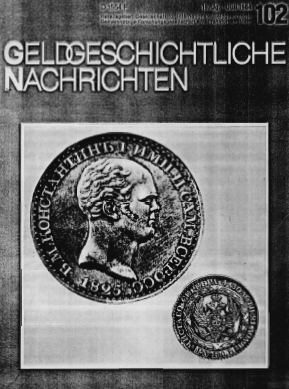
Constantin Ruble
courtesy of Mr. V. ArefievKöhne - 1879

extract from Belgian Jornal of Numismatics on Constantin Rouble
courtesy of Mr. V. ArefievTroubetzkoy - 1873

Rouble de Constantin
courtesy of Mr. V. Arefiev -
Amazing! I am sure when they dance the coins make a satisfying dull sound of silver bells...
-
Thank you Sigi, I wasn't going to buy it. Just wanted to know if this crown is known or not. Sergey has shown me a very similar one, close to identical crown. But interesting if there is this variant of crown in the book. Just a rare variant by the look of it. It is most probably a good original coin, but nowadays one can be sure of nothing. 1781 I have similar one in quality to the one on sixbids.
-
Love you guys!

Sigi, can you check out my new topic please?
-
What do you think, guys, is it original? No one thinks otherwise yet, but one element stands out for me from the rest of the coins I looked through last night. Crown over E.
Sigi, can you please check in the book on these coins, if this variant is mentioned? I couldn't find it on M-DV site.
Original link:
-
Thanks guys... I have old coins every where it seams, apart in the dish-washing machine...
 Some I even forgot I bought... but of cause I'll be keeping the core collection, so 5k1761 MM not an option 🙃
Some I even forgot I bought... but of cause I'll be keeping the core collection, so 5k1761 MM not an option 🙃
-
Great! Thanks. Any other suggestions?
-
Many may have coins of a not high grade or rarity in their collection. I do. What is the best way to sell your "doubles", "triples" and "quadripples", the coins that you probably no longer need and that may still be of interest to a starting collector? Any tips?
Look after your collections and stay well!
-
Have a Happy New Year 2020, everyone! Hope it will be the year when we'll have our interest in numismatics and collecting Russian coins well stimulated with lucky finds coming our way and time to spend on research! Best of luck, best of health and lots of love from the dear ones! 👑 👑 👑 🌲 🌲 🌲 🎅 🎅 🎅
-
This question remains somewhat unanswered for me yet. I am reviewing 7 y. war at the moment to see what else may have happen.
A couple of things are to keep in mind here, I think:
1) In 1760 Russia and Austria occupied Berlin as allies (I think there may have been even German troops involved, but I need to do more reading on that), but decided to withdraw as they hadn't had the backing secured and supplies were scarce. They made a base in another town nearby with safe supply routes, and were preparing for another attack on Berlin in 1760-1761. At that time Elizabeveta Petrovna, who were determined to have a victory, even if she had to sell some of her dresses, as she put it, passed away, and Peter III, who was Friedrich"s II admirer, signed Petersburg's peace agreement with Prussia. Russian troops were ordered to assist Friedrich II against yesterday's allies and withdraw back to Russia, even from territories of East Prussia in which citizens have sworn their loyalty to Russian crown. Including Kunigsberg, where Russia was making local currencies of Russian design in silver and smallest one in copper. Examples:
This made Peter III very unpopular with Russian military and in the country.
Read more on historical aspects to do with Elizabeth ROLE here: http://numistika.com/books/1900 Bain - The daughter of peter the great - Russian diplomacy and court.pdf here is an extract from It. I am yet to find the time to read it all.
2) Meanwhile, in Russia, Shuvalov is pushing for two projects to do with copper coinage. A ) converting old cannons into coins in Sestroretsk, which is approved in 1757. B ) Doubling copper coins nominal (denomination) by overstriking new type Elisaveta Petrovna 's coins and producing brand new coins. This project was rejected in 1760 and in 1761 he tried again and in 1762 Peter III pushes this project through.
Now, the 1760 dies that we have one sided novodels made from, particularly, 4 kopecks, importance of which I demonstrated in the first post are here, and I now have no doubts that they are genuine. Where did they come from?
My understanding is that dies were not usually ordered to be made until there was OK for the project and trial strike was ordered. Though, given the political powers of Shuvalov, rules may not exactly apply here. So, I cannot dismiss that possibility.
There are two theories:
- officially accepted by GM, Uzdenikov and many others, but that has no documental proof, is that dies were pre-made for Shuvalov 's project. Who, I'd assume, has chosen this design for the series as victory series, expecting to celebrate military victory over Prussia. It would also make it easier for the new areas introduced into the Russian Empire to accept this copper coinage.
- Possibly, it was another project where they would try to introduce victory copper coinage of these denominations just to the new Russian territories, as was later done in Siberia. The coinage that was made in Kunigsberg had local elements mixed with Russian imperial elements. Here we have a similar idea.
Frankly, the last theory is probably less likely. In any case, I would assume that armature series dies were trialled in 1760 as Victory series coinage.
In 1762, though Russia didn't loose in the war, but has withdrawn from it, after paying high price in people and money spent on this war, for political reasons in the head of the new Emperor, it was taken by Russian military as sign of weakness and even treason. Even though, I do like the armature series design and take it as originally designs, I must say that releasing "victory" series in these conditions in Russia was a bit of a joke and could be taken by people as insult and a sign that new Russian Emperor has lost his marbles and now was introducing coinage in Russia with Prussian design. No wonder he was quickly replaced.
In any case, the 1760 trial dies, I believe, were designed with victory in mind.
But releasing it in 1762 was one piece of the chain of unfortunate events in Russia...
-
These 2 coins in GM corpus of Russian coins are named as one sided novodels with plain edge. Uzdenikov suggested that they are made with original trial dies of 1760. This is probably true, and there is a little proof for this assumption.
This is 8 Gute Groschen 1754, that I was hunting for the last 2 years, since I realized that for one or the other reason this coins was the one that partly influenced the design of 1762 Russian series of Peter III (prepared by Elizabeth in 1760). Finally, I managed to secure it and looked into this story a little further.
Russian catalogues usually describe the two "lines" on the left that stick out from behind the war drum as "drumsticks".
As we can see, on the Brandenburg's coin, that played as the role of a prototype model, they are no sticks. The lower one is a sword. I am not sure about the top one, may be you can help me here with your suggestion what it could be. Now, on Russian series originally were suppose to be the same military objects, as it would be logically assumed. And if we would closely examine the novodel 4 kopecks that were made, according to Uzdenikov with original 1760 dies, we could see that its image closer to 8 Gute Croschen 1754 than any other 1762 coin may have, with good traces of a sword remaining there.
The remains of sword on Russian coins of this type I could see only on this coin, that is assumed made with trial dies. I couldn't see it on any other Russian coins of this type with military armature. I would assume, now, that 4 kopecks truly were of an early original design, when the master who created the die had 8 Gute Groschen 1754 in front of him, and knew exactly where this image was copied from. I'd say, this is a proof that 4 kopecks comes from the original trial dies.
-
-
Sigi, your persistence and a real eagle eye for rarities often pays off 😻 with rare finds. You are an awesome 5 kopecks detective! Even if the rarities were siphoned out from this hoard left over, it is still an impressive mountain of coins. I'd love to see the actual find!!! I wonder if they could build a pyramid out of it... 😅
-
That's how they look after staying in a clay jar for over 200 years in the ground (or rather river or lake banks' sand) and being cleaned with water. I've seen a few finds like that and many look like this. After proper cleaning some look really AMAZING! Will require a few years in the fresh cabinet after that though... but, I wouldn't by it... only a couple of coins are from Elisaveta's times... and it looks like the pile has already been picked through for rarities...
-
-
Here is another denga 1730 that will join the collection soon. This one is with 2 rosettes (second one is instead of the bow). Just won it on Katz.
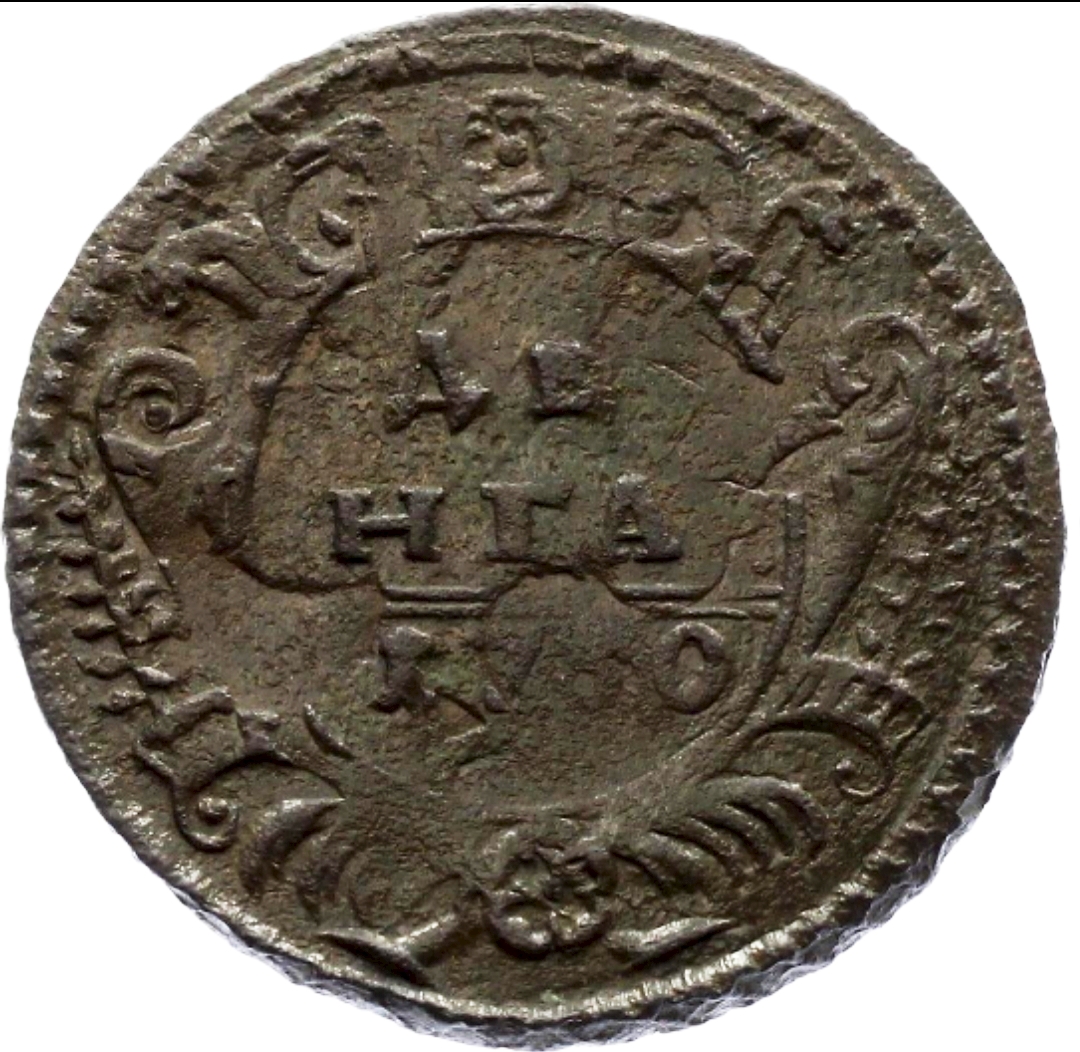
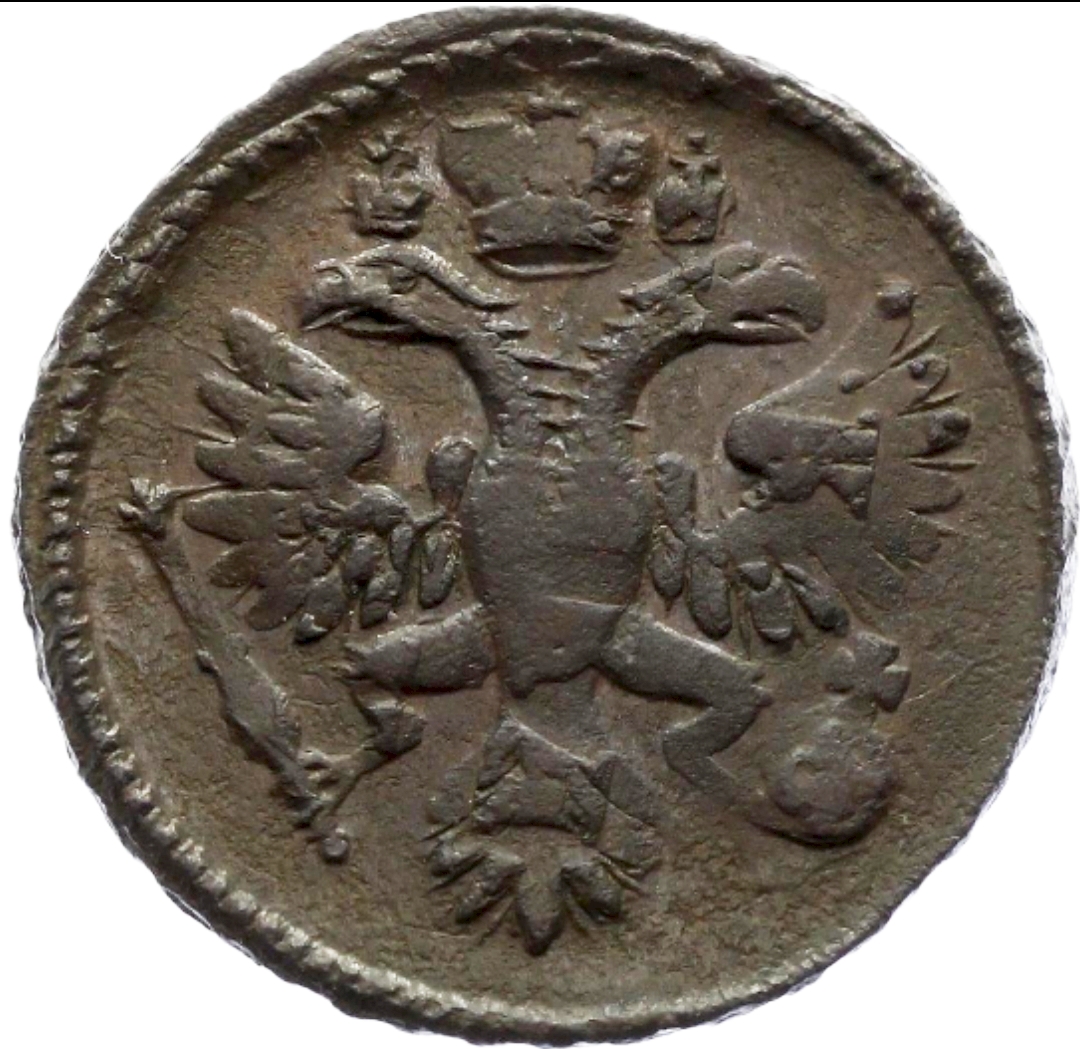
-
Thank you for your evaluation, Dwight. Glad to hear you found book etc. helpful. Happy hunting for interesting coins!
-
Hi Sigi and Dwight,
There were several mints that produced these coins (mostly by overstriking). Generally, we can devide all coins into 3 categories, by main mints' tools that were used: SPM, MM and EM. Coins produced by St.Petersburg mint tools all have 3 flags and eagles of more classical Dasier shapes. Moscow and Ekateringburg tools' coins both have 2 flags, but Moscow shape eagle (with straight left wing) easily sets Moscow tools' coins apart.
There are also many eagle differences in EM coins, that are easy to notice if you study Elisabeth 5 kopecks long enough. Ones you learn to devide coins into groups, you start noticing differences in styles of letter and number shapes, and can learn to recognise coins by seeing only one side of the coin. Sigi is good at that now.

Bitkin is a great basic reference, but not for identifying these coins by mints.
-
Counterfeiters at work :))) :




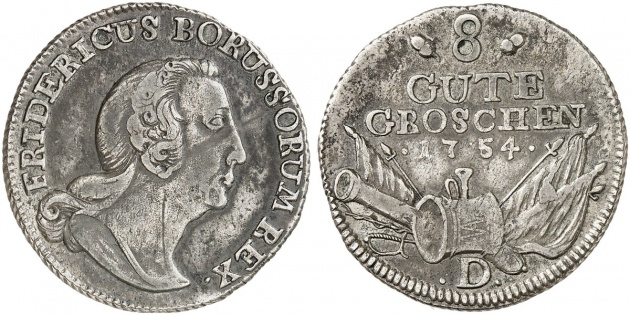





2 kopecks SPM 1760
in Russian Coin Forums
Posted
Officially SPb mint did not issue 2 kopecks of Elizsaveta past 1759.
However, as we know reports aren't always correct... I found a picture of this 1760 coin on one of Russian forums, where it was identified as Moscow mint, which would be expected. If you only look on the coin type (scroll with inscription under St. George, plus overstrike in 1760 could only mean Moscow mint). However, apart from that, the coin is actually screaming (to me at least), that it was made with dies from Saint Petersburg mint. See for yourself: numbers 1 and 7, the form of St. George, overstrike on SPM kopeck, the form and angle of scroll ends - typical for SPM coins:
This is something interesting that I discovered today, thought to share with you, guys...
Happy hunting!